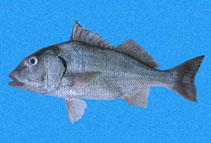| Family: |
Haemulidae (Grunts), subfamily: Haemulinae |
| Max. size: |
45.7 cm TL (male/unsexed); max.weight: 590.0 g |
| Environment: |
demersal; brackish; marine |
| Distribution: |
Eastern Pacific: Gulf of California to Peru. |
| Diagnosis: |
Body robust, somewhat compressed, and not very deep (depth contained 2.8 to 3.0 times in standard length); mouth small and terminal, its posterior end located at the same level as the anterior rim of the eye; profile of head convex; first gill arch with 18 to 23 gill rakers; dorsal fin deeply notched, with 12 spines and 14 to 15 soft rays (XII, 14-15); second anal spine stronger and but shorter than third; third anal spine, when bent, reaching or surpassing base of last anal ray;; back brownish gray; belly lighter; axilla of pectoral fins and upper edge of operculum black (Ref. 55763) |
| Biology: |
Inhabits coastal seas on sandy or muddy bottoms (Ref. 11482). Found in estuaries (Ref. 9114). Feeds on polychaetes, copepods and amphipods (Ref. 50313). Marketed fresh (Ref. 9114). |
| IUCN Red List Status: |
Least Concern (LC); Date assessed: 25 May 2007 Ref. (130435)
|
| Threat to humans: |
harmless |
Source and more info: www.fishbase.org. For personal, classroom, and other internal use only. Not for publication.

